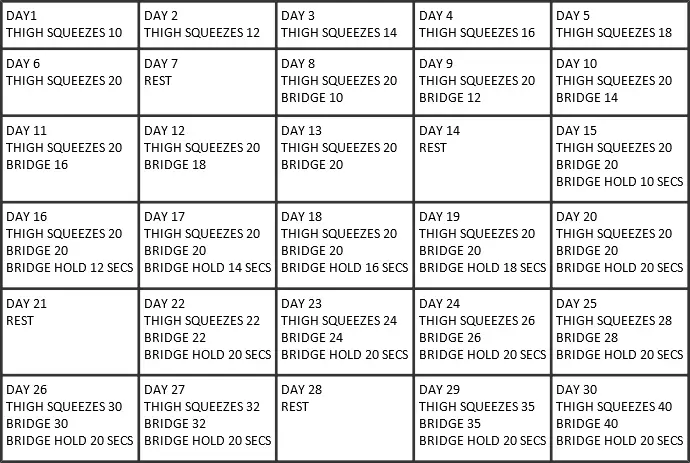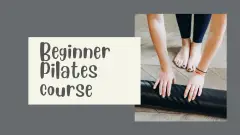The Pilates circle (also known as a Pilates ring or magic circle) is a useful piece of equipment to have for home workouts, because it is cheap, easily stored and versatile. You can use it to work your arms, core and legs. It’s particularly useful for inner thigh exercises, as it’s hard to add resistance to inner thigh work outside of the gym. This Pilates circle challenge uses 3 exercises to strengthen your inner thighs, as well as working your core muscles.
What is the Pilates circle?
The Pilates circle is a very simple design. It’s just a ring of covered flexible metal, with hand grips either side. The purpose Pilates designed it for was to help improve the “connection” between the core and other parts of the body. However, it can also be used to increase the challenge of some Pilates exercises, or as a prop for other (non-Pilates) exercises. Although you don’t see them often in high street fitness stores, Pilates circles are widely available online. See a buying guide here.
Working the inner thighs
The inner thighs are an area that can be flabby and lack tone. The main action of the inner thigh muscles is to bring the leg towards and across the mid-line of the body. In the gym there are machines specifically for this, or cable machines work well too for inner thighs. At home, however, it can be hard to challenge the muscles enough to really make a difference. The Pilates ring is a good solution to this. When it’s between your legs, it creates resistance against the action of your inner thigh muscles. This makes them work hard as you squeeze the ring.
Pilates circle challenge
There are three exercises in this challenge (full instructions below):
Exercise #1 thigh squeezes: lay with your back on the floor and squeeze the ring with your thighs.
Exercise #2 bridge: in this exercise, you hold the ring between your thighs as you lift up and down into the bridge position. This is a Pilates bridge, which means that you roll through your spine rather than just lifting up and down into a glute bridge.
Exercise #3 bridge hold: from day 20 onwards, the third exercise is static holds in the bridge position.
As with all fitness challenges, the idea is to progress by a manageable amount each day. You start off with just 10 thigh squeezes and by the end of the challenge you will have worked up to 40 of each exercise, with a 20 second hold in the bridge position. All the reps and hold counts are on the chart below.
Before you start this challenge, please see these general exercise guidelines. Please also note that holding a muscle contraction for several seconds or more isn’t advisable for those with high blood pressure. If this applies to you, then leave exercise 3 out.
Instructions for exercises
Thigh squeezes

- Lay on the floor with your knees bent and feet flat.
- Position the ring between your legs, just above your knees, with the grips in contact with your legs.
- Now squeeze and release the ring with your inner thigh muscles.
Exercise #2

- Lay on the floor and position the ring as for thigh squeezes
- Grip the ring firmly with your thigh muscles as you curl your spine away from the floor. Lift your lower back first and then try to lift your spine one vertebra at a time until your body is in a straight line with your legs and your weight is supported on your shoulders, as shown.
- Now reverse the movement,. Lower your upper back first and then follow through with the rest of your spine.
Exercise #3
Days 20-30: when you have completed your last lift, hold it here for the number of seconds shown on the chart.
Reps and holds chart
Here are the reps and hold times for each day of the challenge. You can also get a printable version of the chart by entering your e-mail address in the box below.

Related to Pilates circle inner thigh exercises challenge
Challenge FAQs
The first day of the challenge should feel like it needs a bit of effort, but not too much. If you really struggle with day 1, then you probably won’t get through the challenge. The idea with the challenges on this site is that the first few days get you used to the exercises and the daily habit. Usually about halfway through the challenge the effort levels start to increase more quickly.
Avoid challenges that increase effort levels very quickly – they’re simply not realistic. It’s unlikely that, for example, you would be able to increase how many squats you are able to do by 10 a day for 30 days, or increase your plank hold time by 10 seconds a day for 30 days.
In general, allowing muscles 48 hours between workouts is good because it gives our bodies time to recover and adapt. Challenges are generally short workouts and for a limited period of time (usually 30 days), so not having many rest days won’t be a problem. With challenges that alternate exercises each day, it’s not an issue, because you’re using different muscles.
Fitness improvements don’t always happen in a predictable way. Sometimes we’re just not as strong or energetic for no apparent reason, or we hit a plateau. If you get to a point where you’re struggling to complete the day’s challenge, you can try one of the following:
- Take a couple of days off and start again where you left off
- Do the challenge on alternate days rather than every day
- Instead of increasing the effort every day, stay at the same level for 2 or 3 days and then go onto the next day of the challenge
Obviously these solutions mean the challenge will last longer, but you’ll still benefit from doing it.

